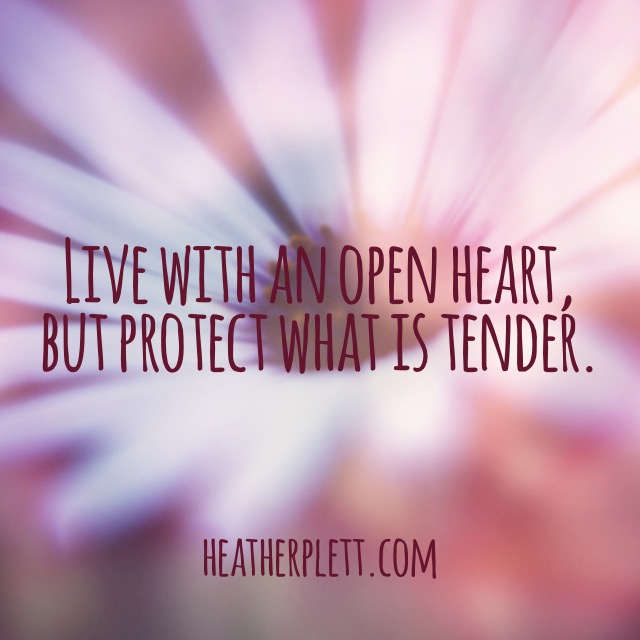by Heather Plett | Dec 28, 2016 | connection, grief, growth, holding space, journey, Labyrinth

Sometimes grief comes like a runaway truck. You can see it careening down the highway toward you, but you don’t have enough time to get out of the way before it flattens you.
Sometimes it’s a slow moving train, and you’re stuck at the crossing, impatiently waiting for it to pass so that you can get on with your life.
Sometimes grief is a stealth bomber, dropping missiles from the sky and leaving you with an unfamiliar and sinister landscape that you don’t know how to navigate.
This Christmas, grief came to me like a sailboat – not disruptive or forceful, but with a strong enough wake to rearrange the pebbles on the shore.
It came in the dark while I was driving down the highway, on the way home from a full day of Christmas merriment at my brother’s house. It came on the same road where, six years earlier, I told my husband that, unless something changed, I couldn’t stay in the marriage any longer. It came while my daughters were peacefully sleeping in the van behind me. I was glad for the cover of darkness to hide the tears streaming down my face.
There is a unique grief that becomes part of your narrative when you’ve lost both parents and the partner you thought you’d spend the rest of your life with. It feels untethered – like there is nobody holding you to the ground anymore and you have to figure out how to do your own holding. It comes with a unique loneliness – a feeling of separateness – when you’ve lost those relationships at the first level of intimacy and the best that you now have is second-level intimacy. Those people care that you’re there and they love you dearly, but their eyes won’t light up when you walk into the room, and their hand won’t reach out to touch yours in a way that says either “you are my child” or “you are my beloved”.
I’d just spent the day with the people I adore (my siblings and their families), and my van was full of three girls whose love lights up my life, and yet I felt an undeniable sense of loneliness.
It was not unhealthy, this loneliness, nor was it even particularly painful. When it came, I felt no desire to banish it or even to resolve it in any hurry. There is no gaping hole in the centre of my heart; there is only a gentle gap that offers possibility for more fullness in the future.
I simply felt the longing in the loneliness and let it keep me company as I drove.
Longing is not something to be banished or feared. Longing is a friend, a messenger that points us in the direction of our hearts. Like a treasure map, it gives us clues that help us figure out where to dig.
Longing is what helps us make connections – with ourselves, with each other, with the sacred, and with the earth. We are meant for connection, to be in relationships that help us thrive and grow. If we didn’t ever feel longing, we would never seek each other out. We would live in isolation, never building communities, never taking the kinds of risks that result in intimacy, passion and aliveness.
Longing and love go hand in hand. Love grows in the world when we respond to our longing and reach out in connection and community.
My longing pointed me toward intimacy, touch, and deep soul connection.
There are many beautiful connections in my life, and for that I am grateful. But there’s a level of intimacy – both physical and emotional – that’s missing, and that is what my longing asks me to open my heart to.
There are other clues on this treasure map as well – clues that tell me that, in order to find the treasure of intimacy, more excavation will be required. I will need to continue to clear out the emotional clutter – old stories and attachments – that don’t serve me anymore. I will need to continue to heal the wounded parts of me that fear the deep vulnerability that comes with intimacy. I will need to soften the parts of me that keep me guarded and protected.
This past year has included a lot of excavation, a lot of decluttering, and a lot of dismantling of old stories. Now, at the end of it, I feel ready to sit with the empty spaces in my heart – the longing and hunger that comes when the old has been removed and the new has not yet come to fill its place. I feel ready to sit at the centre of the labyrinth – emptied of what I needed to release on the journey inward and ready to receive what has yet to arrive.
With this writing, I am suddenly aware of what my word for 2017 will be. My longing pointed the way to it.
My word for 2017 is intimacy.
What about you? Do you feel a deep longing right now? An ache in your heart that won’t go away? If so, what is it trying to teach you, what connection is it telling you to seek out?
Don’t chase it away and don’t fear it. Let it enter you, let it teach you, and let it point you toward the treasure you have yet to uncover.
*****
If you’re interested in exploring your own longing and want to pick a word for 2017, A Soulful Year may be a useful resource.
******
Interested in more articles like this? Add your name to my email list and you’ll receive a free ebook, A Path to Connection and my bi-weekly reflections.
by Heather Plett | Feb 17, 2016 | connection, growth, holding space, Intuition, journey, practice

“But it hurts if I open it too much.”
That’s what I hear, in some form or another, every time I teach my Openhearted Writing Circle or host openhearted sharing circles.
People show up in those places hopeful and longing for openness, yet wounded and weary and unsure they have what it takes to follow through. They want to pour their hearts onto the page, to share their stories with openness and not fear, to live vulnerably and not guarded, and yet… they’re afraid. They’re afraid to be judged, to be shamed, to be told they’re not worthy, to be told they’re too big for their britches. They’ve been hurt before and they’re not sure they can face it again.
And every time, I tell them some variation of the following…
An open heart is not an unprotected heart.
You have a right, and even a responsibility, to protect yourself from being wounded. You have a right to heal your own wounds before you share them with anyone. You have a right to guard yourself from people who don’t have your best interests at heart. You have a right to keep what’s tender close to your heart.
Only you can choose how exposed you want to make your tender, open heart. Just because other people are doing it, doesn’t mean it’s the right thing for you.
Yes, I advocate openhearted living, because I believe that when we let ourselves be cracked open – when we risk being wounded – our lives will be bigger and more beautiful than when we remain forever guarded. As Brene Brown says, our vulnerability creates resilience.
HOWEVER, that doesn’t mean that we throw caution to the wind and expose ourselves unnecessarily to wounding.
Our open hearts need protection.
Our vulnerability needs to be paired with intentionality.
We, and we alone, can decide who is worthy of our vulnerability.
We choose to live with an open heart only in those relationships that help us keep our hearts open. Some people – coming from a place of their own fear, weakness, jealousy, insecurity, projection, woundedness, etc. – cannot handle our vulnerability and so they will take it upon themselves to close our hearts or wound them or hide from them. They are not the right people. They are the people we choose to protect ourselves from.
Each of us needs to choose our own circles of trust. Here’s what that looks like:

In the inner circle, closest to our tender hearts, are those people who are worthy of high intimacy and trust. These are the select few – those who have proven themselves to be supportive enough, emotionally mature enough, and strong enough to hold our most intimate secrets. They do not back down from woundedness. They do not judge us or try to fix us. They understand what it means to hold space for us.
In the second circle, a little further from our tender hearts, are those people who are only worthy of moderate intimacy and trust. These are the people who are important to us, but who haven’t fully proven themselves worthy of our deepest vulnerability. Sometimes these are our family members – we love them and want to share our lives with them, but they may be afraid of how we’re changing or how we’ve been wounded and so they try to fix us or they judge us. We trust them with some things, but not that which is most tender.
In the third circle are those who have earned only low levels of intimacy and trust. These are our acquaintances, the people we work with or rub shoulders with regularly and who we have reasonably good relationships with, but who haven’t earned a place closer to our hearts. We can choose to be friendly with these people, but we don’t let them into the inner circles.
On the outside are those people who have earned no intimacy or trust. They may be there because we just don’t know them yet, or they may be there because we don’t feel safe with them. These are the people we protect ourselves from, particularly when we’re feeling raw and wounded.
People can move in and out of these circles of trust, but it is US and ONLY us who can choose where they belong. WE decide what boundaries to erect and who to protect ourselves from. WE decide when to allow them a little closer in or when to move them further out.
How do we make these decisions? We learn to trust our own intuition. If someone doesn’t feel safe, we ask ourselves why and we trust that gut feeling. Sometimes we’ll get it wrong, and sometimes people will let us down, but with time and experience, we get better at discerning who is safe and who is not.
We also have to decide what to share in each level of the circle, but that’s a longer discussion for another blog post. For now I’ll simply say…
Trust your intuition. Don’t share what is vulnerable in a situation that feels unsafe. Erect the boundaries you need to erect to keep your tender heart safe. Let people in who have your best interest at heart.
This article has been voluntarily translated into Farsi.
If you want to explore your own open heart, you’re welcome to join an Openhearted Writing Circle, or consider booking a coaching session. For a self-guided journey to your own heart, consider The Spiral Path, which remains open until the end of February.
Interested in more articles like this? Add your name to my email list and you’ll receive a free ebook, A Path to Connection and my weekly reflections.



